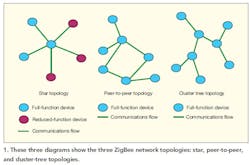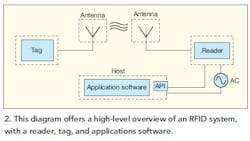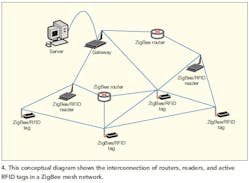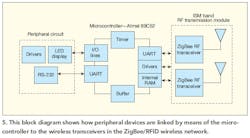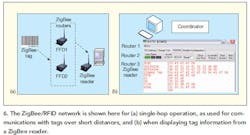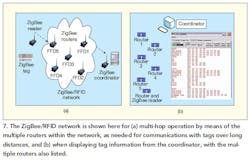This file type includes high resolution graphics and schematics when applicable.
ZigBee and radio frequency identification (RFID) are two wireless technologies that have each developed hosts of applications independent of each other. Each has benefits, with ZigBee supporting advanced sensor networks and RFID suitable for low-power wireless tracking of people and objects. By combining the two technologies, it is possible to create a ZigBee mesh network with integrated active RFID tracking capability one in which RFID tags within the network can communicate with each other. ZigBee is outlined in IEEE standard 802.15.4, which defines the physical and Medium Access Control (MAC) layers.1,2 The ZigBee Alliance is an industry association that supports the use of the technology, enabling it for Wireless Sensor Networks (WSNs).3 The open standard supports low-speed, low-cost wireless networking with long device battery lifetimes, as well as low latency. The ZigBee standard supports multiple topologiesnamely, star, peer-to-peer, and mesh configurations.2,4,5 The technology establishes layers for security, wireless networks, and application framework based on the IEEE 802.15.4 standard and the ZigBee topology.6
ZigBee-compliant products operate in two main modes: non-beacon and beacon. In beacon mode, the network coordinator periodically sends out a beacon signal to devices within a network while controlling power consumption, with the network appearing like a mesh or cluster tree configuration.
In contrast, the non-beacon mode is simpler and uses peerto- peer networks. It operates like a two-way radio network.7,8 ZigBee technology is suitable for a wide range of monitoring activitiesa list that includes building automation, health monitoring, automated meter reading equipment, grain storage, remote controls, heating and cooling control devices, fans, and structural integrity.9-12
The technology displays three different device types that operate in a self-organizing application network: ZigBee Coordinators (ZC); ZigBee Routers (ZR), which are Full Function Devices (FFDs); and ZigBee End Devices (ZED), which are Reduced Function Devices (RFDs). These physical devices are used to create a ZigBee network.13,14 The ZC acts as the network head and is typically mains powered, and there can only be one PAN coordinator in a network. The ZR, which is an FFD, can perform the function of routing the data between the nodes. ZEDs are the leaf nodes. They check the availability of the nodes to send data, have minimum functionality and reduced function devices, and are always battery-powered.15 The ZC starts by sending a beacon frame to all its neighbors. When the node accepts the framework of the beacon, it can be sent within the request to join the network.16,17Figure 1 shows the mesh, cluster tree, and star network configuration.2
RFID technology stores and remotely retrieves data using devices called RFID tags or transponders. A tag is a device that can be applied to a product, animal, or person for the purpose of identification and tracking using radio waves.18,19 The history of RFID is integrated with the history of other automatic data capture devices, such as bar codes.20,21 The RFID system consists of RFID tags (a microchip with a coiled antenna), readers, and a computer network. Figure 2 shows the general layout of an RFID system. The RFID reader sends out electromagnetic (EM) energy that forms a magnetic field. The microchip, which contains data for the object to which is it attached, modulates the EM waves and generates a new series of EM waves containing information that is read by the RFID reader.22,23
RFID tags can be either active or passive devices. While both use RF energy to communicate between a tag and a reader, the methods for powering the tags are different. Active RFID devices are self-powered and contain a battery within the tag; passive RFID tags are inductively powered by the reader, and this power allows it to transmit its information back.24-26
An RFID reader, also called interrogator, consists of an antenna, an RF receiver, and signal-processing circuitry. The antenna couples the EM energy transmitted by the transponder to the reader and the connection to the server that links the information into the enterprise. An RFID reader can normally read multiple tags within its read range simultaneously, which may be determined by the power available or the frequency of the tag.24,26
Currently, many commercial applications for RFID systems exist; RFID is already driving shifts in supply chain and retail capabilities. Other applications include ID badges and access control, car tracking in rental lots, airport security checks (passports and baggage), tracking livestock and pets, and timing for sports, inventory control, and product tracking through manufacturing and assembly, supply chain management, tollpayment, and libraries.27-30
Both ZigBee and RFID use RF technology for communication, but each has a different implementation. ZigBee is not a substitute for RFID, but is actually a network platform enabling device. This article highlights ZigBee's capabilities and how a ZigBee network can collaborate with RFID devices to enhance factors such as battery power consumption, robustness, extension of ranges, and communication with appliances, as well as other networked devices.
Active RFID tags can communicate data at long range and operate under harsh conditions for years at a time without human interference. They can be integrated with different sensor types to monitor the change of conditions such as temperature, humidity, and pressure. This is similar to the components of an end device in a ZigBee system. A ZigBee radio includes a transceiver, which sends a unique identification number, a microprocessor to store and process data, and sensors attached to the device link tool.
The overall activity of an RFID reader is received by a number of RFID tags at one time in a single hop, although clarification may be directed to a single tag. This activity consumes power on-board the active tag, reducing battery life. Moreover, collisions may occur when several tags try to provide information to the RFID reader at the same time and on the same channel. While ZigBee supports a large number of nodes, which can run on a single battery for several years with a low-current or sleep mode to effectively save power consumption, this is not so with routers or coordinators. With the latter, a sleep state is allowed by time synchronization. A ZigBee end device (tag) can be awakened from sleep mode periodically to perform its scheduled task. With all these features, a ZigBee end device (RFD) can act as an active RFID tag (provided it has the appropriately developed program) with the capability of operating in rugged environments for years at a time, performing independent monitoring, and initiating or controlling communications.
For monitoring, ZigBee-based mesh networks can be used with an active RFID reader layer for connection with active RFID tags while operating with the ZigBee system's lower power consumption compared to an active RFID reader. Moreover, the basic ZigBee bit rate of 250 kb/s is adequate for transferring data in an RFID system. With multiple sensors, each sensor forms a node on the network, sending or receiving data to and from any other nodes. This enables the nodes to form a mesh or an ad hoc network that can self-configure and selfheal, maximizing reliability and minimizing the cost of network deployment and maintenance. RFID readers contain a networking element that connects single RFID read events with element-wired Ethernet or WiFi wireless events.
Figure 3 shows how a ZigBee system can enable active RFID tags and reader layers. Connecting the readers to the central processing unit through the wire connections is a potential solution, but it is inappropriate if readers are placed at geographically distributed locations. However, in the case of two-way wireless communication between the RFID reader and the server, the ZigBee's multihopping technique between the readers (ZigBee routers) enables the connection between the readers and the server, especially for applications where the readers are far from the server. Figure 4 shows how ZigBee can be implemented in active RFID devices, while the table shows the advantages of using ZigBee with RFID compared to RFID alone.
The XBEE Series2 product from Digi International is an Industrial- Scientific-Medical (ISM) band RF transmission module programmed for use as a ZED with transparent operation as an active RFID tag and receive and transmit capabilities in a wireless transmission physical layer. A Hall-effect switch is used for long-time operation as an RFID tag. A ZED module will typically be in sleep mode before authentication within the network. After it is connected to a router or coordinator, it must be able to transmit or receive RF data through that router or coordinator. In this case, the Digi active RFID tag is powered by a 3-V lithium coin battery.
The RFID reader in this study employs a model 89C52 power-saving microcontroller from Atmel as the main control chip for executing communication protocols for data acquisition and network transmission for communication with a wide range of different external-devices. Two sets of low-power ZigBee RF transceivers with RP-SMA antenna are used for wireless transmission in the physical layer. They are programmed with the following function set: ZigBee Coordinator AT, transparent operation for active RFID reader, and RFID reader with power management function and a RS-232 interface. The other interface will be represented as a liquid-crystal-display (LCD) screen along with various light-emitting diodes (LEDs) and DC/DC converters (Fig. 5).
The ZigBee module, referred to as "RF + MCU," is set up as a ZigBee reader. It incorporates both RF and microcontroller functionality, with two XBEE Series2 chips and a model 89VC52 microcontroller. In the ZigBee/RFID system, one ZED with development software is set to use as an RFID tag with the capability of returning a unique identifier (ID) to a nearby scanning reader. ZigBee transceivers automatically form a mesh network with any ZigBee transceiver in range with the same network ID and frequency range.
Two sets of ZigBee devices are used as wireless routers in this self-healing mesh network, using the IEEE 802.15.4-2007 protocol to relay messages. The ZigBee reader is connected to the host system through an RS-232 serial interface. The reader is used to receive and display the data from the two remote routers. In this experiment, a ZED was used as an active RFID tag. When this tag appears within the range of a ZigBee reader, it will send its own information which is further analyzed and processed by the software system running on the base station connected to the ZigBee reader.
Figure 6(a) shows the ZED in active RFID tag mode, when a tag can often be reached in a single hop. This kind of communication is good in short distances as the nodes have limited power and can transmit to limited distances. Figure 6(b) shows an example of an active ZigBee tag within range of the network. This case is suitable for short-distance communications, although a multi-hop scenario would be used for longer distances.
Five sets of ZigBee devices were used as wireless routers/transceivers in a selfhealing mesh network configuration, using the IEEE 802.15.4-2007 protocol to relay messages deployed between the coordinator and the ZigBee reader when they are separated by some distance. Figure 7(a) shows this system when an active ZigBee tag is may not often be reachable in a single hop, where multihop operation is needed. One ZigBee device is set as the coordinator (gateway device), responsible for creating the Zig- Bee network. It is connected to the host system through an RS-232 serial interface and used to receive and display the data from the five remote routers. ZigBee modules were designed and tested to serve as FFDs.
Figure 7(a) presents an overview of how ZigBee can be used in RFID system applications with multi-hop communications. The ZigBee coordinator and five ZigBee routers create the network and are ready for relaying messages from the ZigBee tag to the coordinator. The ZigBee reader joins the ZigBee network through one of those routers. The active ZigBee reader collects tag data, relays the information packet to the first RF transceiver controller on the ZigBee reader, then broadcasts the packet wirelessly through the second low-power ZigBee RF transceiver to a network of wireless transceivers in the mesh network. Figure 7(b) shows the interface when an active ZigBee tag is not in the range of the network, and how the combination of ZigBee and RFID technologies can be used to great benefit, using multi-hop communications for communications taking place over long distances.
In this experiment, the ZigBee reader performs the collection command every one second with a read range to 100 ft. With ZigBee, the read range of the RFID system was extended via mesh routing, which allows data packets to traverse multiple nodes (hops) in a network to route data from any source to any destination. The minimum interval time for the ZigBee reader to send out tag information can be as short as 200 ms while successfully reading ZigBee tag information. The ZigBee protocol provides a great deal of flexibility and stability for an RFID system by finding alternate routes to transmit data if there is a node down or obstruction blocking its line of sight. In a conventional RFID system, a failed node can lead to read errors as well as to a nonfunctioning system.
This extended coverage and effectively improved reliability can dramatically improve the read performance of an RFID system by using ZigBee modules as ZigBee readers for the RFID tags. ZigBee transceivers effectively become part of a selfforming network, integrating the RFID tags within the network when all parts of the network are identified under software control.
Continue on page 3
Page Title
In short, RFID and ZigBee are key wireless technologies that serve a wide range of applications as separate solutions, and can provide enhanced performance when integrated within a common system. An integrated ZigBee and RFID system architecture performs the needs of multiple applications with more capability than stand-alone RFID products. It can deliver exgtended range as well as savings in power consumption when all the network components are coordinated. As shown here, the implementation of an integrated ZigBee/RFID system is straightforward and can work with wireless protocols, enabling RFID devices to communicate with one another as well as with other networked devices using various applications.
Acknowledgments
The authors would like to thank the School of Electrical and Electronic Engineering, Universiti Sains Malaysia (USM) and the Secretariat of USM Research University Fund (814101) for sponsoring this work.
References
1. M.A.B. Sarijari et al., "Wireless Home Security and Automation System Utilizing ZigBee based Multi-hop Communication," in Telecommunication Technologies 2008 and 2008 2nd Malaysia Conference on Photonics, NCTT-MCP 2008, 6th National Conference on Telecommunication Technologies, 2008.
2. P. Kinney, "ZigBee Technology: Wireless Control That Simply Works, Communications Design Conference, October 2, 2003.
3. ZigBee-Alliance, ZigBee specification, www.ZigBee.org, 2006.
4. A. Wheeler, "Commercial Applications of Wireless Sensor Networks Using ZigBee," IEEE Communications Magazine, Vo., 45, No. 4, 2007, pp. 70-77.
5. I. Howitt and J. Gutierrez, IEEE 802.15. 4 standard on low rate-wireless personal area network coexistence issues, 2003, IEEE, www.ieee.org.
6. S. Ondrej et al., "ZigBee Technology and Device Design," in Networking, International Conference on Systems and International Conference on Mobile Communications and Learning Technologies, ICN/ ICONS/MCL, 2006.
7. E. Callaway et al., "Home networking with IEEE 802.15.4: a developing standard for low-rate wireless personal area networks," IEEE Communications Magazine, Vol. 40, No. 8, 2002, pp. 70-77.
8. T. Kim et al., "Performance Analysis of IEEE 802.15.4 with Non-beacon-enabled CSMA/CA in Non-saturated Condition," Lecture Notes in Computer Science, No. 4096, 2006, p. 884.
9. H. Kim, J. Chung, and C. Kim, "Secured communication protocol for internetworking ZigBee cluster networks," Computer Communications, Vol. 32, 2009, pp. 1531-1540.
10. Y. Lin et al., "ZigBee Sensor Network for Structural Health Monitoring," National Center for Research on Earthquake Engineering, 2006.
11. H. Kim and O. Ayurzana, "Improvement of data receive ratio in remote water meter system by upgrading sensor," International Journal of Control, Automation and Systems, Vo. 7, No. 1, 2009, pp. 145-150.
12. H. Zhou et al., Applications of ZigBee Wireless Technology To Measurement System in Grain Storage, Springer, New York, 2009.
13. C. Misal, "Analysis of Power Consumption of an End Device in a ZigBee Mesh Network," University of North Carolina, Raleigh-Durham, NC, 2007.
14. J. Cho and S. An, "An Adaptive Beacon Scheduling Mechanism Using Power Control in Cluster-Tree WPANs," Wireless Personal Communications, Vol. 50, No. 2, 2009, pp. 143-160.
15. G. Wittenburg et al., "Fence monitoringexperimental evaluation of a use case for wireless sensor networks," Lecture Notes in Computer Science, No. 4373, 2007, p. 163.
16. K. Benkic, P. Planinsic, and Z. Cucej, "Custom wireless sensor network based on ZigBee," in ELMAR, 2007.
17. D. Gislason, ZigBee wireless networking, Newnes, 2008.
18. Y. Wang et al., "The research of RFID middleware's data management model," IEEE International Conference on Automation and Logistics, ICAL, 2008.
19. B. Zoghi et al. Wireless Sensor Monitoring Combined with RFID Networks. in IJME-INTERTECH Conference, 2006.
20. E. Jones and C. Chung, RFID in Logistics: A Practical Introduction, CRC, Cleveland, OH, 2007.
21. J. Landt, The history of RFID, IEEE Potentials, Vol. 24, No. 4, 2005, pp. 8-11.
22. B. ztay, S. Baysan, and F. Akpinar, "Radio frequency identification (RFID) in hospitals," Technovation, Vol. 29, No. 9, 2009, pp. 618-624.
23. A. Nambiar, "RFID Technology: A Review of its Applications," Proceedings of the World Congress on Engineering and Computer Science 2009 Vol II, WCECS 2009, October 20-22, 2009, San Francisco, CA.
24. O. Shoewu and O. Badejo, "Radio frequency identification technology: development, application, and security issues," The Pacific Journal of Science and Technology, Vol. 2, 2006, pp. 144-152.
25. Savi Technologies, "Active and Passive RFID: Two Distinct But Complementary Technologies for Real-Time Supply Chain Visibility," SAVI Technologies White Paper, 2002.
26. L. Ni et al., "LANDMARC: indoor location sensing using active RFID," Wireless Networks, Vol. 10, No. 6, 2004, pp. 701-710.
27. F. Liu, Y. Zou, and W. Liao, "Standard System Framework of RFID Application in Logistics," Third International Symposium on Intelligent Information Technology Application, IITA, 2009.
28. W. Dong-Liang et al., "A brief survey on current RFID applications," International Conference on Machine Learning and Cybernetics, 2009.
29. Z. Pala and N. Inanc, "Smart Parking Applications Using RFID Technology,"Proceedings of the First Annual RFID Eurasia Conference, pp. 1-3.
30. A. Reza and T. Geok, "Investigation of Indoor Location Sensing via RFID Reader Network Utilizing Grid Covering Algorithm," Wireless Personal Communications, Vol. 49, No. 1, 2009, pp. 67-80.


